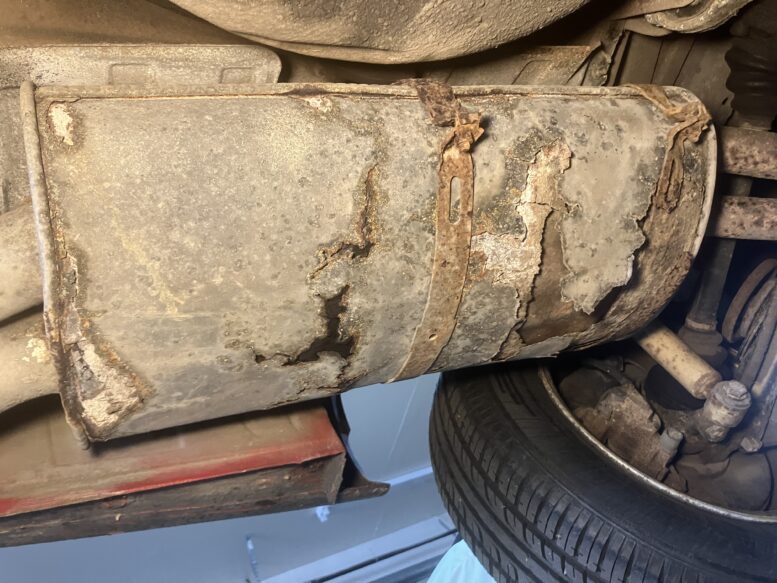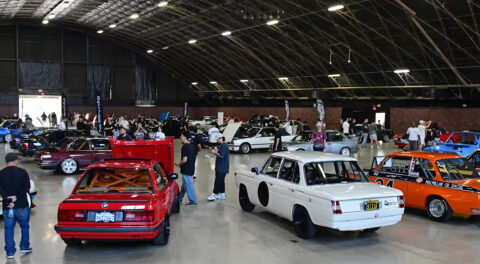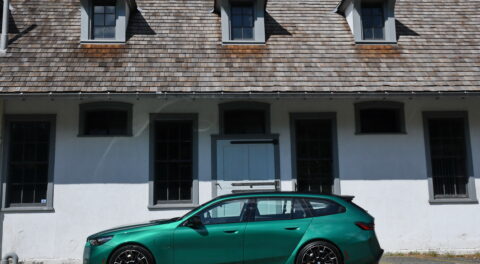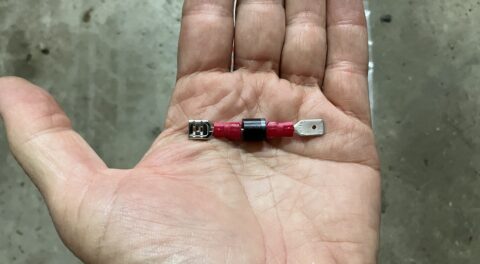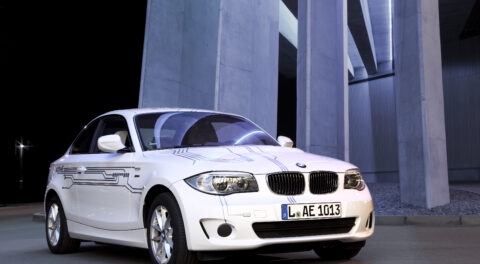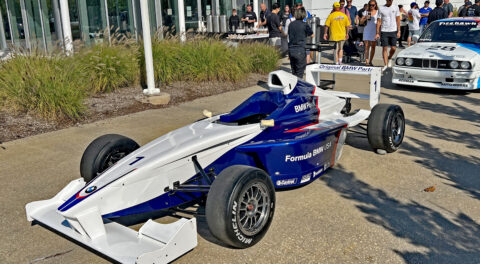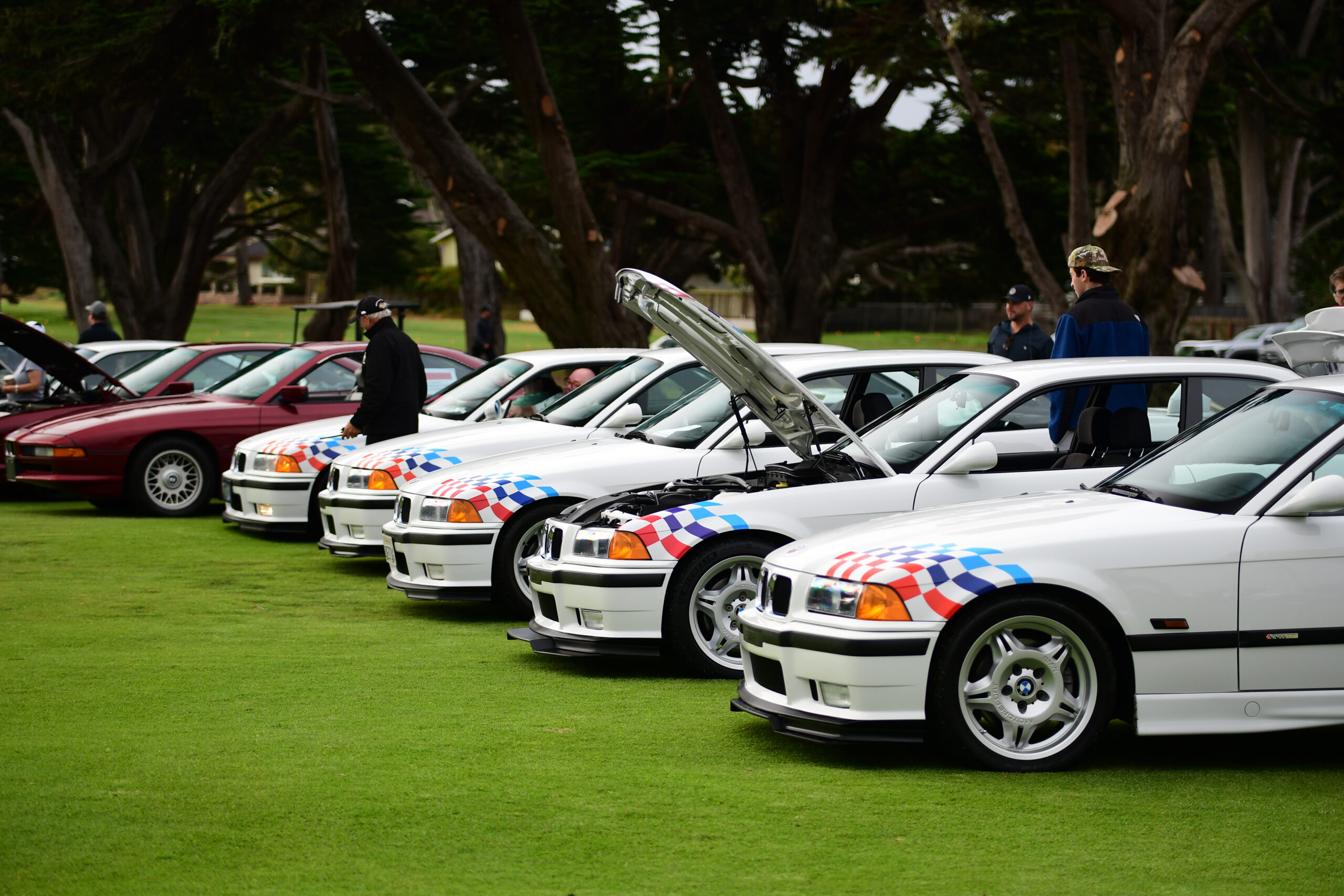First, let me follow up on something from my “Springtime Odds and Ends” piece a few weeks ago. The brake and ABS lights in my E39 were on, the speedometer had become intermittent, and the cruise control had stopped working. The odds seemed strong that these were all due to the ABS control module. I’d experienced these same symptoms ten years ago when I bought the Z3, and fixed it myself by cutting the module open and reflowing the solder joints. I tried this on the E39, but the module is a generation newer, the components are all much smaller than they were on the Z3, and are encased in transparent sticky goo. Some folks recommended Module Masters (who I think I used years back for something else), but their $300 price gave me pause. I found Auto Truck and Electronics (ATE) on eBay. I contacted them first to be certain they’d take on a module that I’d already cut open, but for $150 plus shipping both ways, they repaired it, sent it back to me quickly, and it solved my problem. I am a happy customer.
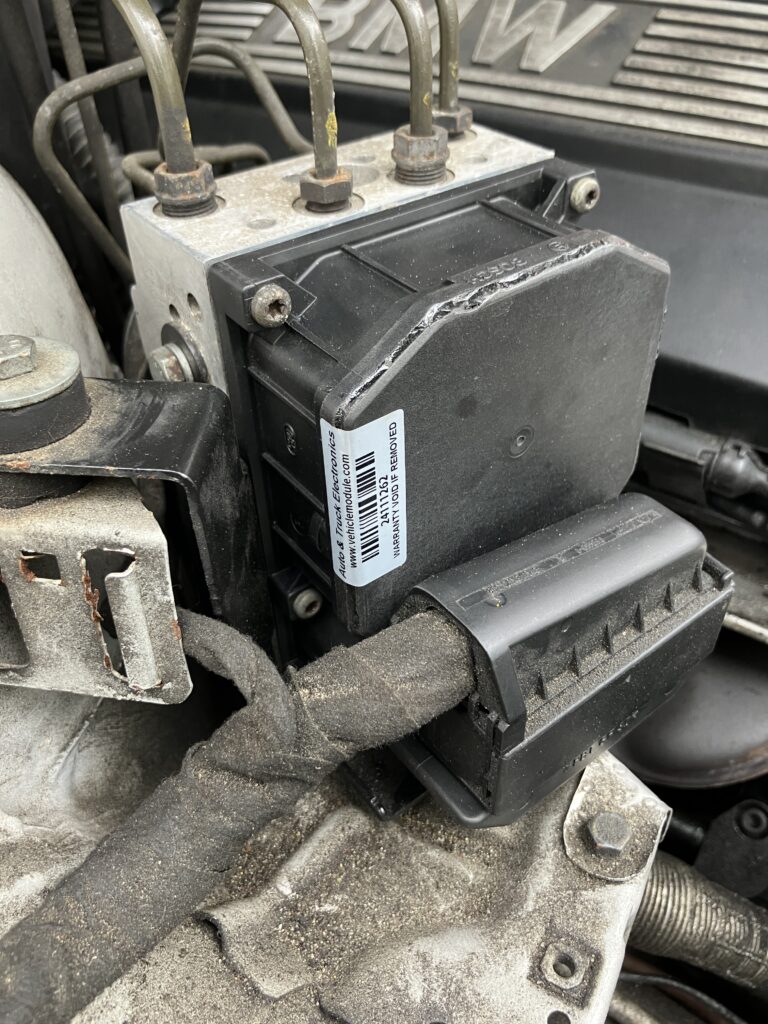
Would that all automotive repairs were as easy as pulling out, sending off, and reinstalling an ABS control module in an E39.
Back to the main show. With departure for The Vintage scheduled for Wednesday May 14th, and with the FrankenThirty running well and with working air conditioning, I allowed myself to deal with some nonessentials. The first was the car’s exhaust. When I bought it and stuck my head under it to assess the rust condition of the undercarriage, I was thrilled to find essentially zero rust-through on any of the body panels or frame sections. However, the car’s muffler was badly rotted. So before the whole Franken-car thing reared its ugly head, or before I knew how mouse-contaminated the car was, I had “replace muffler” high on the punch list.
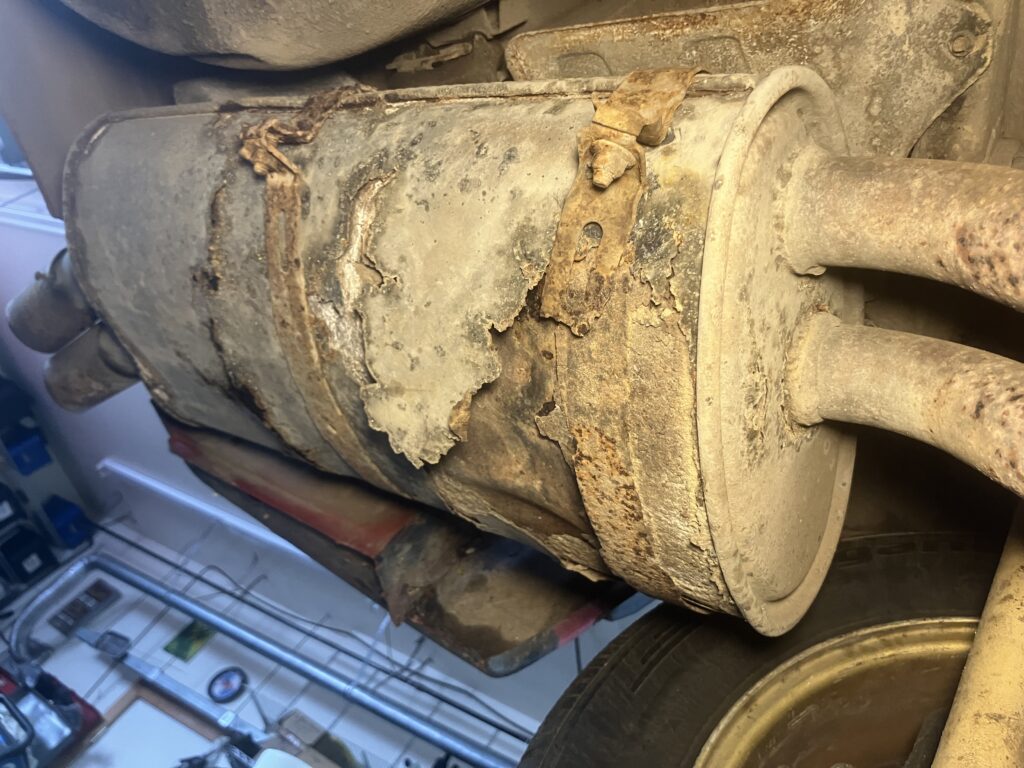
I’d call that replace-it-now bad.
As the car’s condition and needs became known, and as the muffler surprisingly didn’t begin sounding like a cherry bomb, it dropped off the list entirely. Well, not entirely; I knew it would need one eventually, so I kept half an eye open for a well-priced used cat-back exhaust. Over the winter, one showed up on Facebook Marketplace. A young man half an hour north of me had not one but two exhausts, one from the front pipes to the rear of the muffler, the other the entire section behind the cat. It was hard to tell from the photos exactly what the exhausts were, but at $50 for the pair, the price was certainly right. It turns out the father (Joe DiBiasi) was a CCA member who had been reading me for decades, and his son Peter was an enthusiast as well whose E30 had unfortunately been totaled.
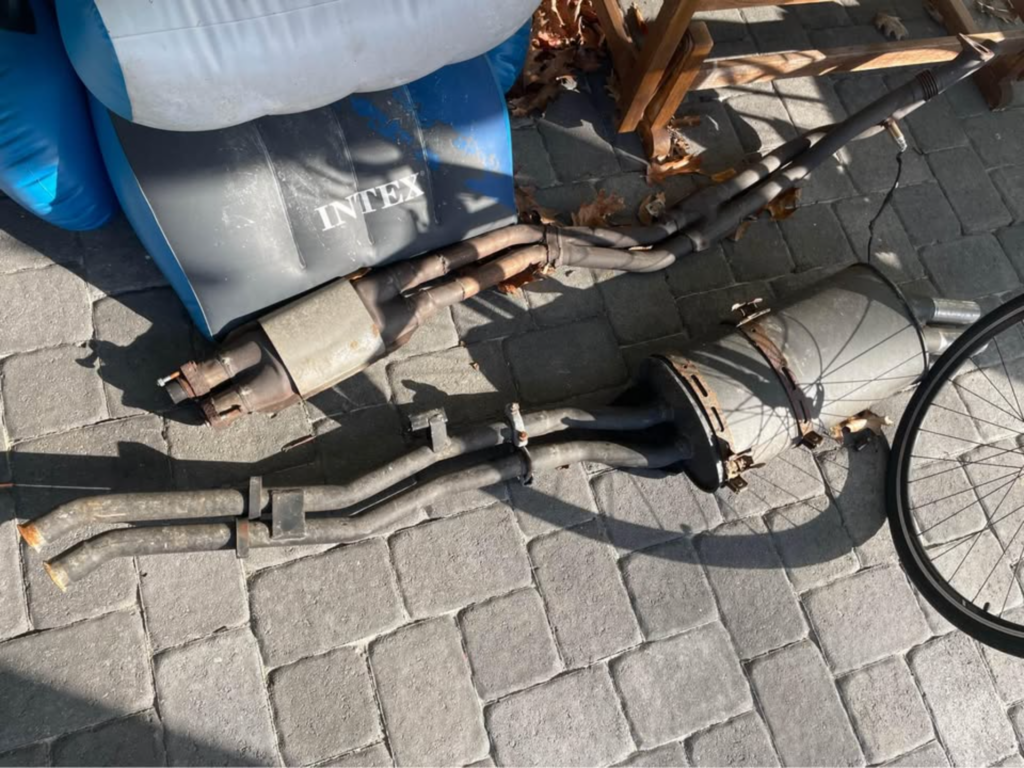
Could be anything, right?
The cat-back exhaust turned out to be an Italian-made Imasaf, which looks remarkably like an Ansa (I see references online to Imasaf’s being one of Ansa’s manufacturing partners in Italy). The exhaust looked to be in excellent condition, and the big wrap-around clamps that came with it were far better than the rusty ones currently on the car. Although installing it was by no means a must-do repair prior to leaving for The Vintage, the condition of the muffler on the car was so bad that the odds of it blowing a hole during the 2000-mile trip seemed high. With the car running well, the a/c working, and time on my hands, I had at it. Not really being an E30 person, and with the Franken-car-thing about being the rear 2/3 of a facelifted 325is and the front 1/3 of a pre-facelift yet wearing an Eta engine, the first thing I did was assure myself that the replacement exhaust would fit. I slid it beneath the car, lined it up, and assured myself it had bends in the same places.
Fortunately, unlike my recent work on my 2008 Nissan Armada’s exhaust, the FrankenThirty’s exhaust had stout flanges that I wasn’t worrying about damaging during removal. And I didn’t need to cut anything. With heat, the four nuts spun off their bolts. The cat-back exhaust was heavy enough that I pressed my son Ethan into service holding up the tailpipe while I undid the bolts on the big muffler clamps. I easily slid off the stretched rubber hangers, and we lowered the rusty exhaust to the ground.
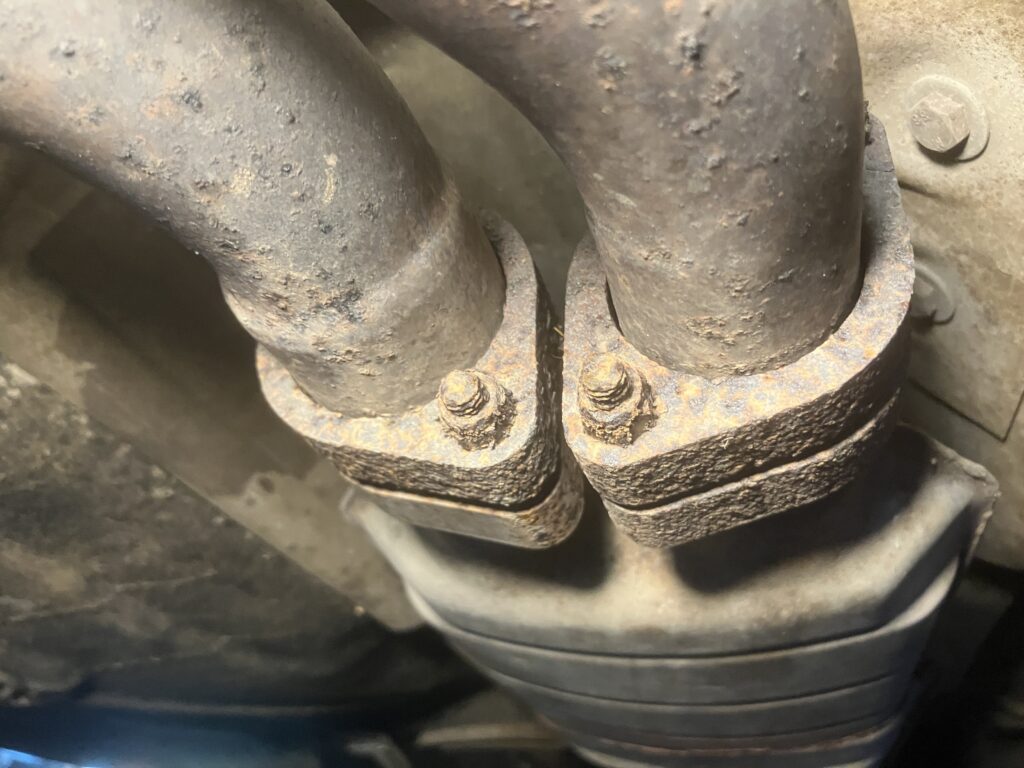
These looked good and solid.
I had forgotten that the flanges aren’t identical—that the right one holds a solid metal ring but the left one employs a crush-ring. I had three of the former in my exhaust parts box, but none of the latter. I searched online and found that there was one of the equivalent Walker crush-rings in stock at an O’Reilly Autoparts about half an hour away. I called to make sure they actually had it. The woman was kind enough to lay hands on it. I asked her if she could verify that it was a crush ring and not a solid metal ring. I heard some rustling of plastic and then “Oh no!” It had broken apart in her hand. I think she felt worse than I did. I said that if that happened to her, it would’ve broken when I installed it. Fortunately the one in the car was usable.
Since the saggy old rubber donuts that hold the two muffler clamps are inaccessible once the exhaust is in place, and since I had two new ones in my exhaust parts box, I installed them. I also put a new “double-D” hanger (the same one used in a 2002) on the bracket on the underside of the car to hang the bracket on the exhaust from. Ethan held up the tailpipe while I slid the pipes over the back of the cat and put the bolts through them and the big muffler clamps. It was then that I noticed a problem: The bracket at the front of the exhaust didn’t line up with the “double-D” hanger suspended from the bracket under the car.
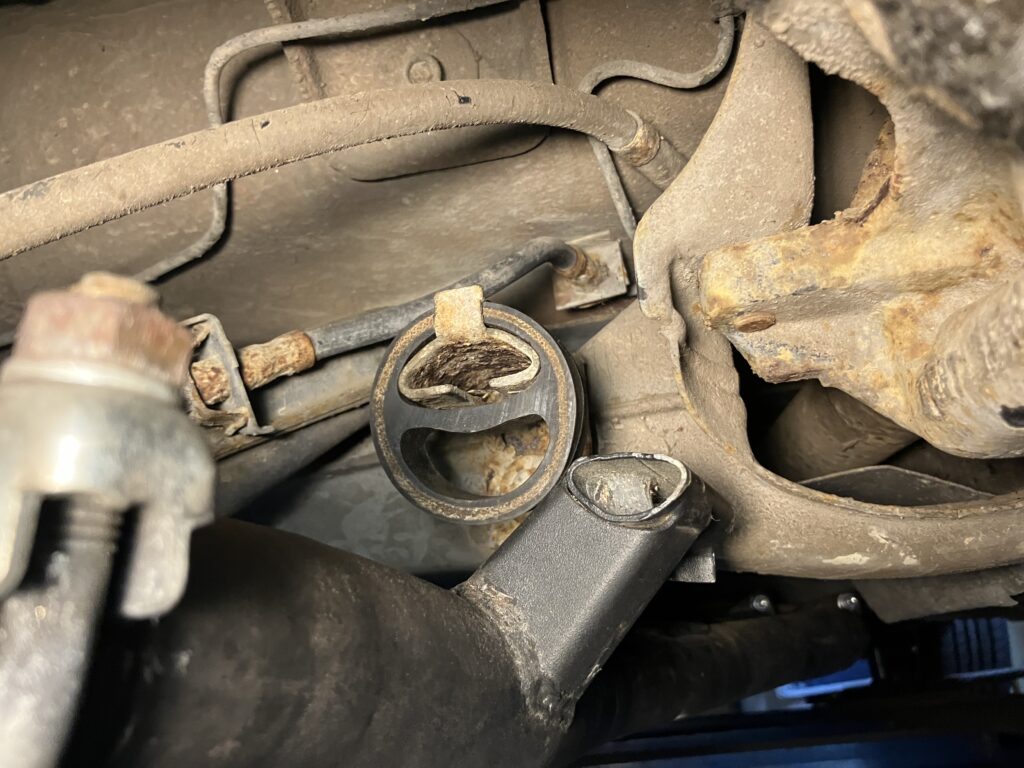
Hmmmn.
I later learned that the Eta-engine cars have the exhaust hanger in a different place than the “i” cars because the Eta cars have the cat connected to the muffler with a single pipe whereas the “i” cars have twin pipes, but a) according to its VIN, this car is an “i” car, and b) it has a two-pipe cat in it (witness the pipe flange photo above). It was very odd. While the exhaust seemed in no real danger of sagging, I addressed it by taking one of the stretched-out rubber donuts and passing it around the two offset brackets.
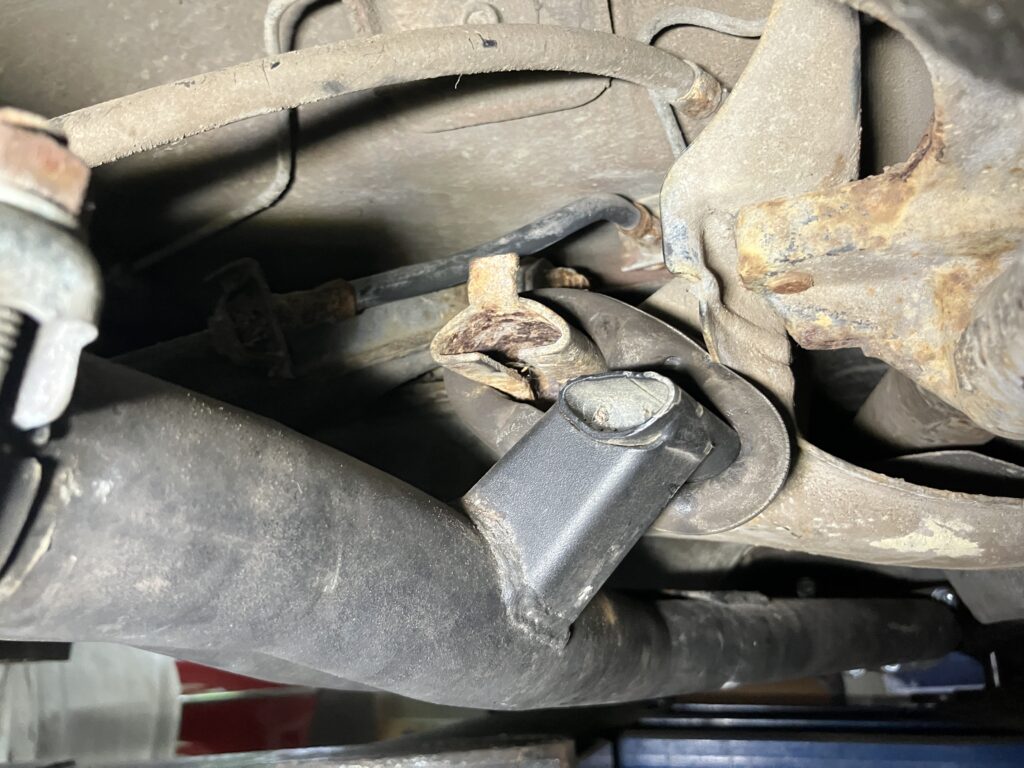
Good enough for FrankenThirty work.
Another problem was that the new rubber donuts pulled the muffler so high and tight that the left-leaning tailpipe was hard up against the left side of the cut-out. Since the FrankenThirty is far from a pristine car, and since this part of the rear clip had already seen some action, I took the Sawzall and lightly clearanced it.
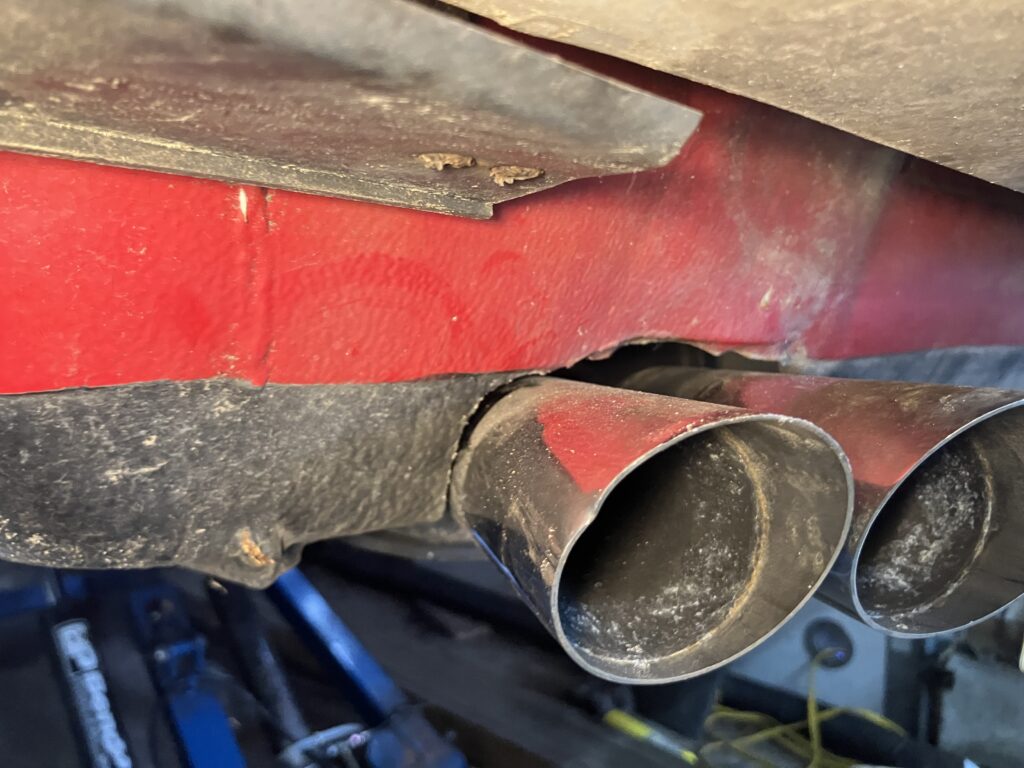
What’s the clearance, Clarence?
And with that, the car had a solid and nearly-new exhaust that, when I drove it, to my delight, wasn’t in the least bit throaty.
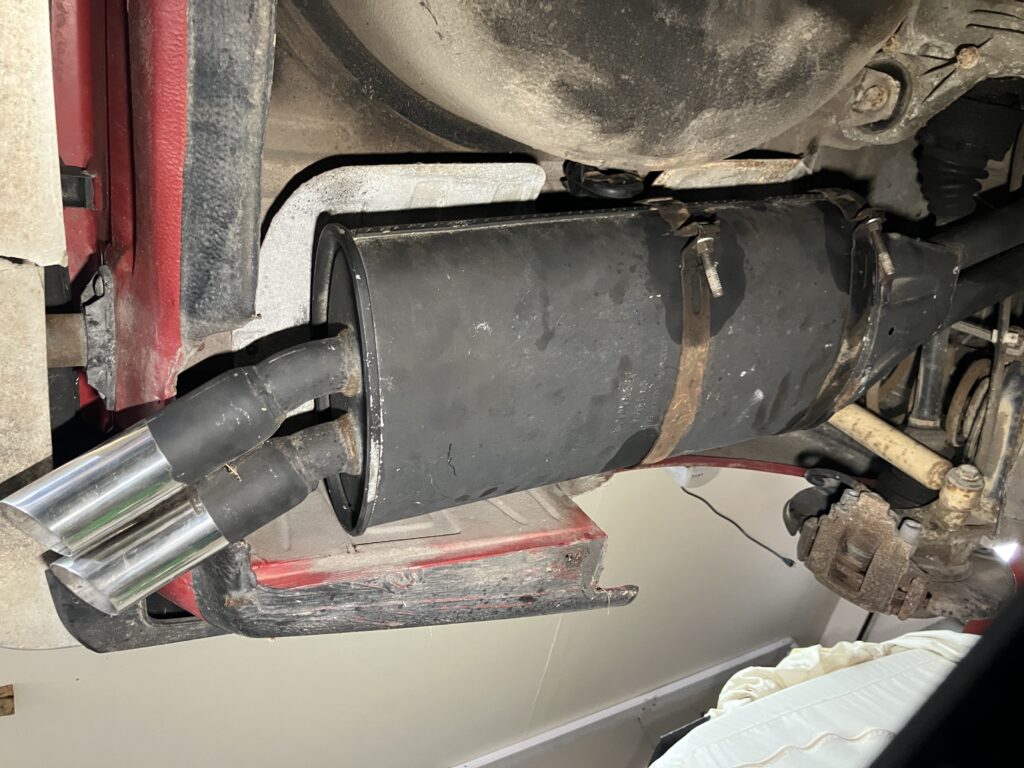
As The B52s sang, “Doesn’t that make you feel a whole lot better?”
The next issue was that, while I’d eliminated the mouse motherlode last fall when I cleaned the cowl and the heater box, the remnant rodent smell in the car is still larger than I’d like. Not surprisingly, there’s a reason for that. A few weeks ago while I was driving the car, the passenger-side dome light dropped out of the headliner, and I noticed that is backside was covered with bits that were clearly mouse nesting material. Further, with the dome light hanging in the breeze, having the open portal to the inside of the headliner seemed to turbocharge the mouse smell. This made me peel back the door weatherstripping and peek inside the headliner from the door edge. What I found was not good.
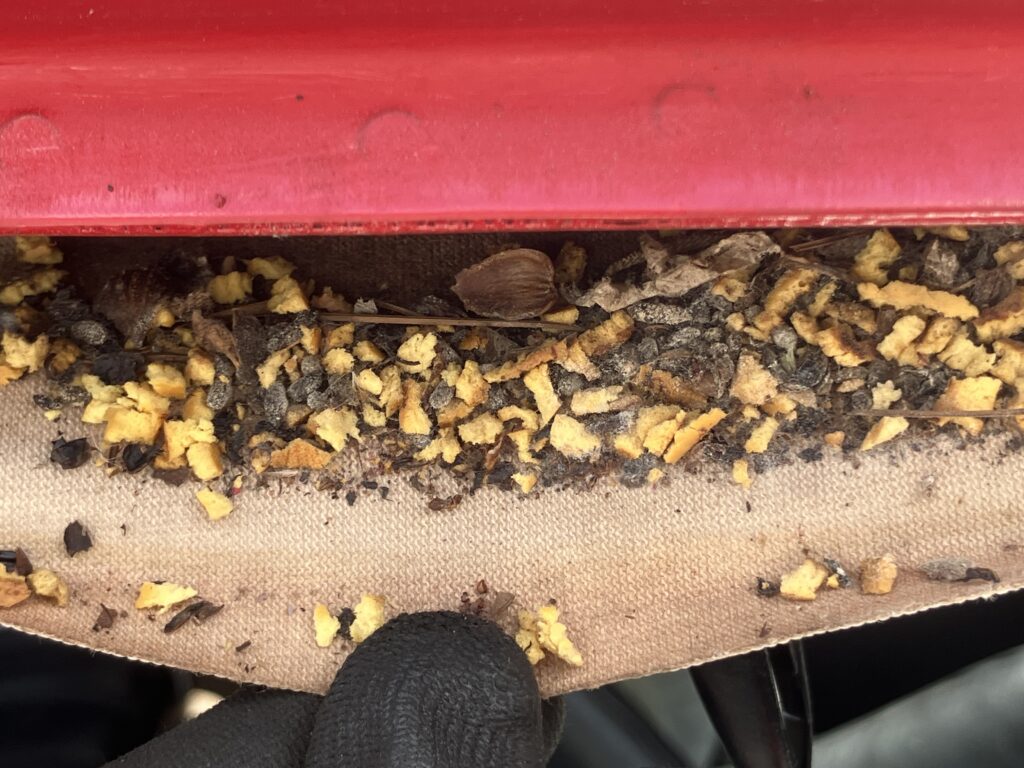
Mice. Why is it always freaking mice?
If you recall, when I bought the car last August, the sunroof was sagging due to a broken piece of the plastic track, so it was effectively an open mouse motel for who knows how many years. I reached inside the headliner with the thin crevice nozzle of the shop vac and sucked up what I could, then sprayed in enzyme-based cleaner. A few days later, while on a simultaneous FrankenThirty shake-down drive and a visit to some old college friends, I stopped in on Tim Donahue of BMW Buyers of New England in Willimantic CT and bought a dome light and the mounting bracket (as well as a trunk spare tire cover and an “S” badge; see below). The combination of the vacuuming and the portal to the headliner being closed knocked the mouse smell back to annoying but not gag-worthy levels.
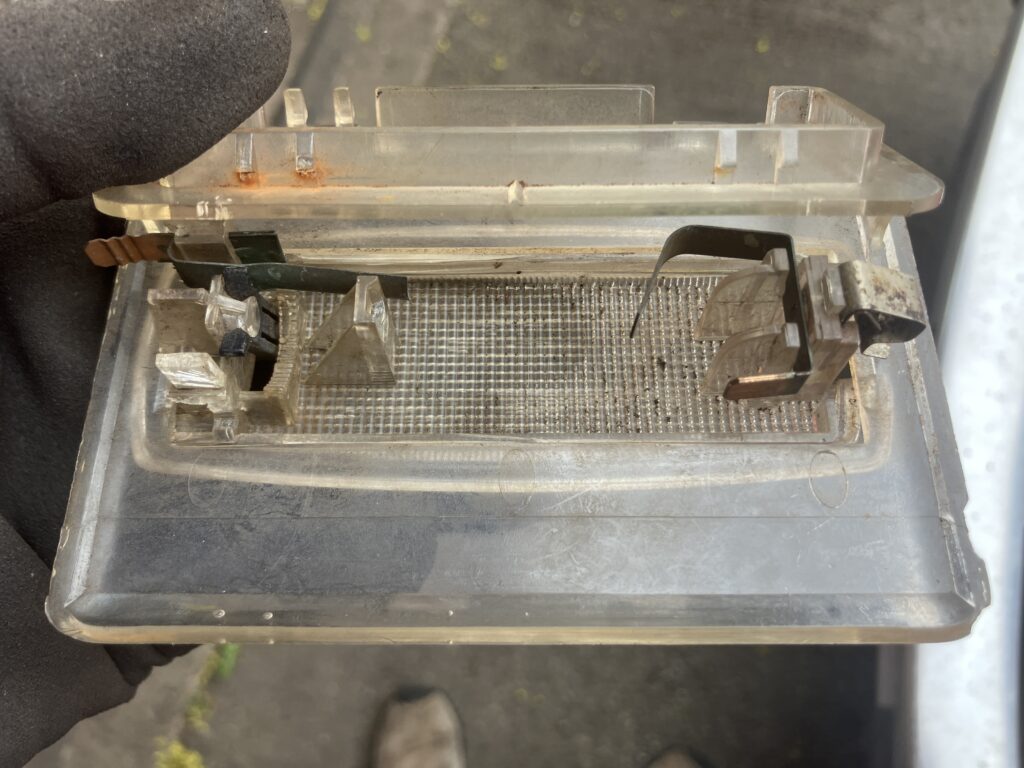
A used dome light and its fragile breakage-prone mounting bracket.
Next, to potentially lessen the mouse smell coming from residual contamination inside the cowl as well as to address some wetness on the carpet during heavy rain, I taped up both cowl vent trim panels. Obviously, this is only feasible since I now have the a/c now working. If the lack of fresh air becomes problematic (for example, if I can’t keep the windshield defogged with only the a/c), I can just pop the passenger-side taped-up vent panel off.
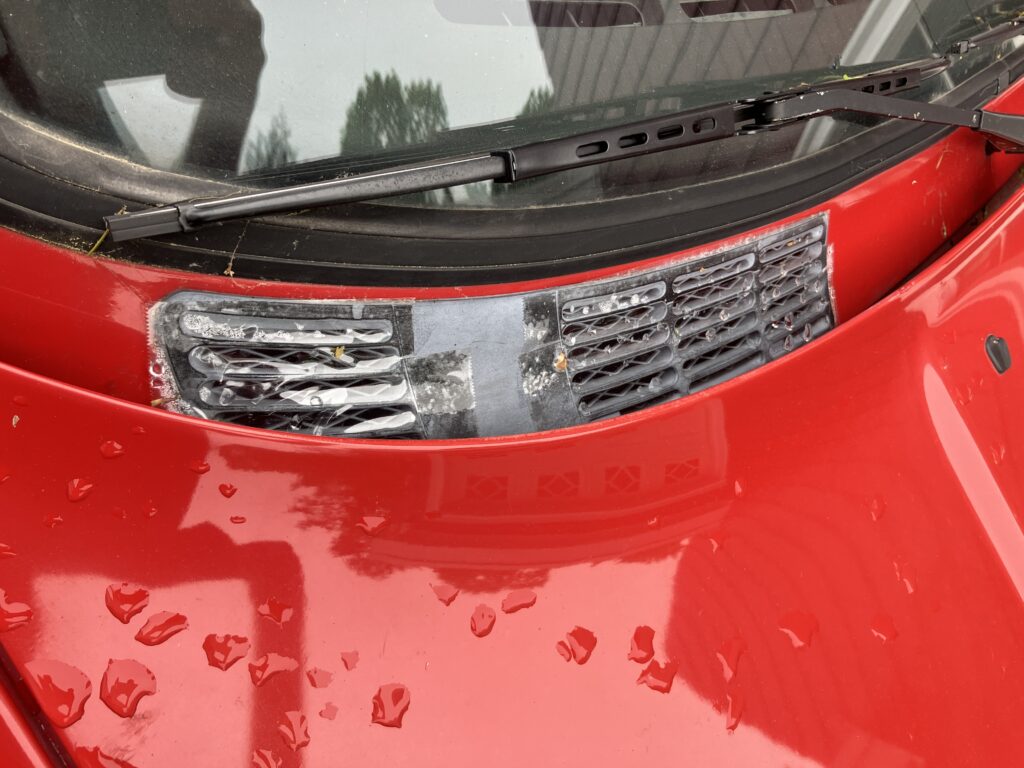
Hacky but practical. I guess that’s redundant.
Small repair #4 was to affix the base of the accelerator pedal, as the notches in the tabs were no longer enough to keep it in place in the bracket welded to the floor. Two small screws in two small holes did the trick.
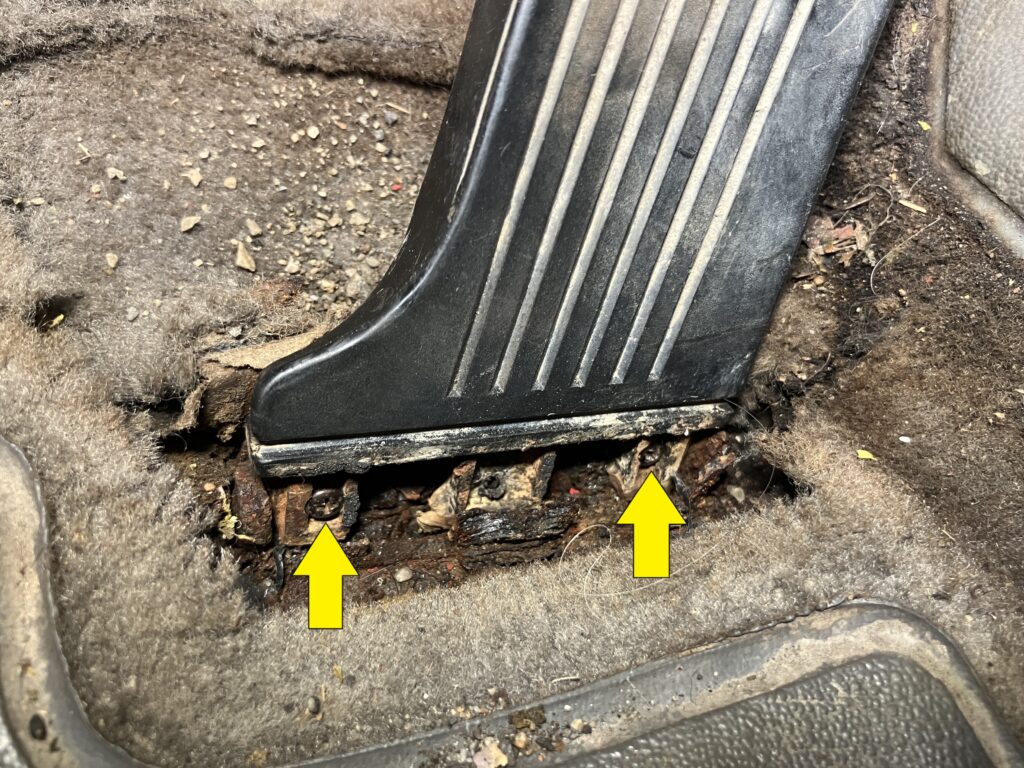
Easy peasy.
Next to last was the sound system. In recent years, I haven’t listened to music often on drives to The Vintage, as, even with a/c, the wind noise inside the vintage cars is loud enough that the music volume needs to be at an ear-fatiguing level to be heard, but the E30 is much quieter than the 2002s or the E9. As a 325is, this car has the premium system with the Alpine CM5908 “pyramid” radio/cassette deck and the door-mounted tweeters, but the Alpine has only worked intermittently. I had removed it during the a/c resurrection, and when I put it back in and entered the code, it came up being largely functional, so I ordered an $8 cassette-aux adapter on Amazon. Unfortunately its functionality then declined again. First it stopped searching for stations. Then it began beeping every five seconds when I shut off the ignition, and I could find no way to stop the beeping other than to pull the fuse. And after I reinserted the fuse, the radio wouldn’t accept the code. A vintage car like an E30 deserves its correct radio, but a working one would be nice.
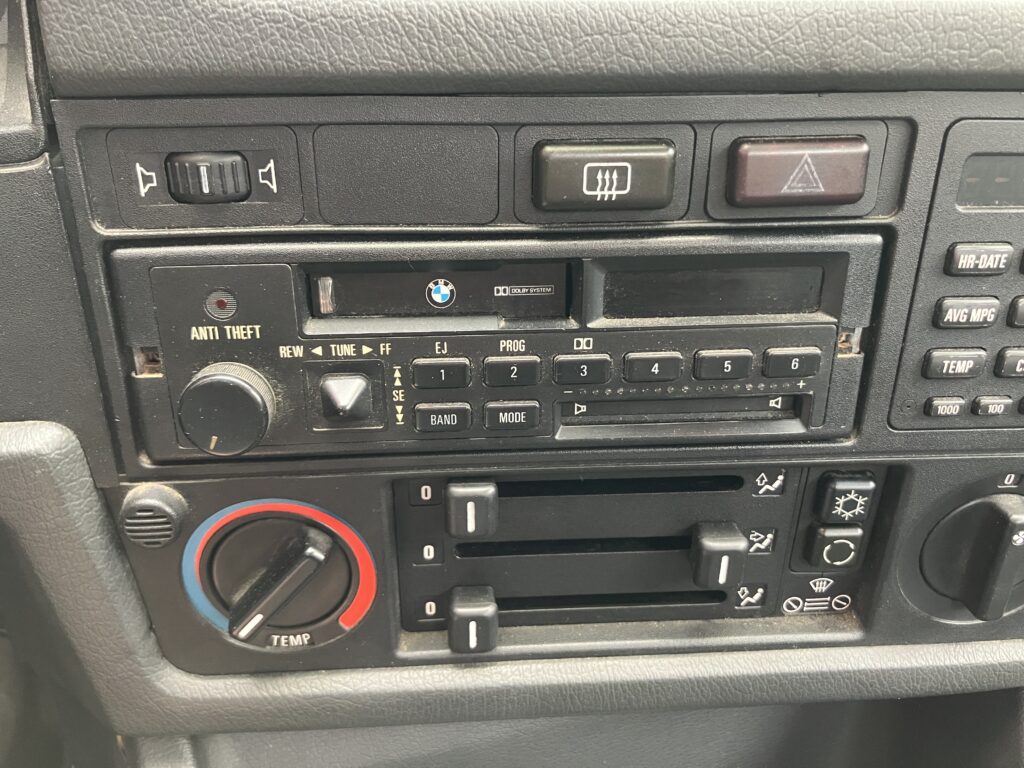
Even dead, I do like the look of the correct radio in the dash.
So I fell back to what I used to do in my cars that have made the trip to The Vintage: I installed a portable subwoofer-and-satellite system. I have a 25-year-old Cambridge Soundworks Model 12 system in a hardshell case that sounds fantastic, but the E30 is a bit small for that, and with it already having rear deck-mounted speakers, that shelf is pretty space-constrained. So I used my other system, which is a Cambridge Soundworks PC Works system you can buy used for $20. Its advantage is that the subwoofer has a 12V jack on the back, so you can power it off a cigarette lighter. And its two satellites are small enough that I could zip-tie them to the top of the rear seat belts. I can feed it music directly from my old-school iPod or through my phone with a lightening plug adapter. And if someone steals it, I don’t care.
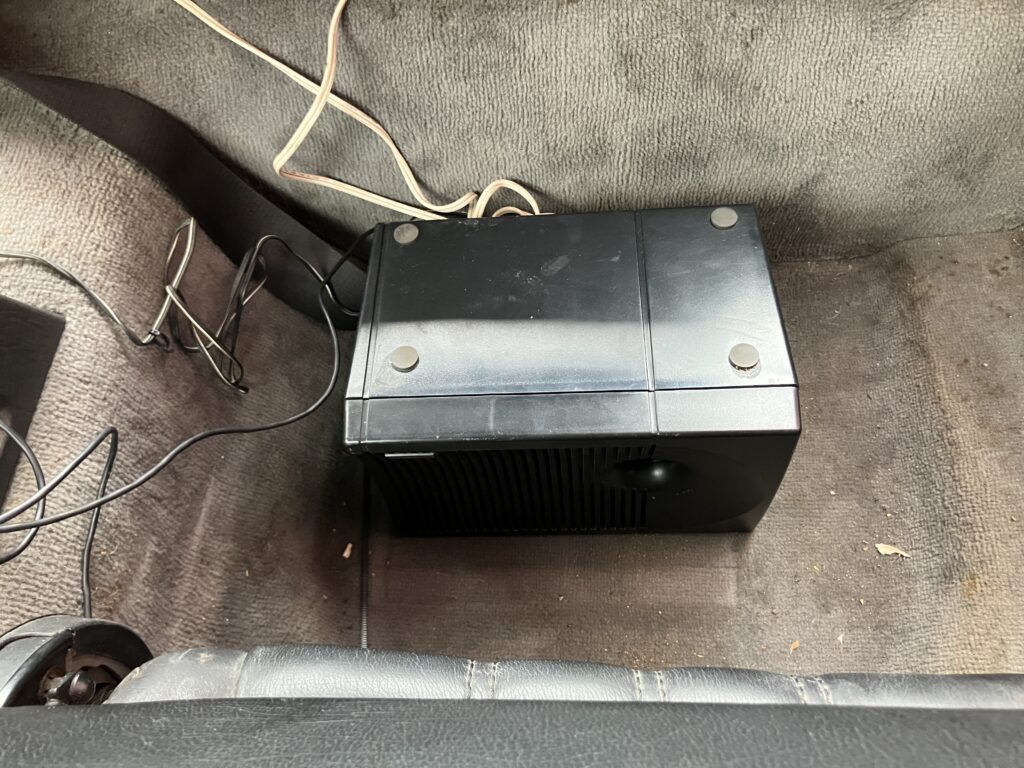
The sub on the floor behind the driver’s seat.
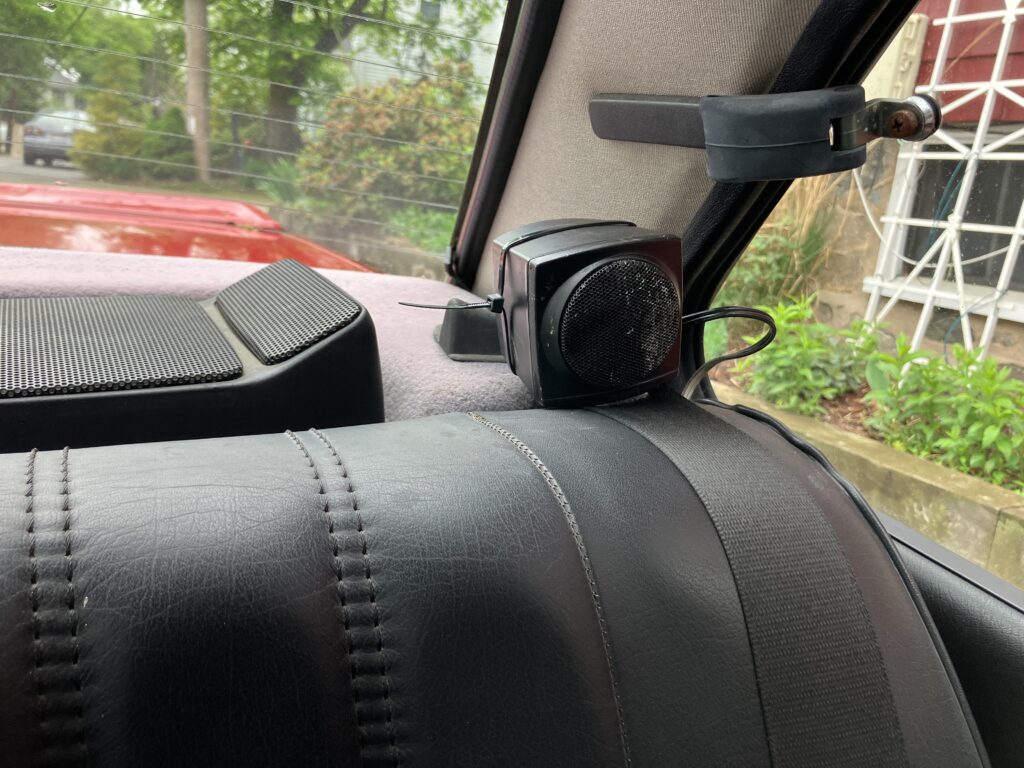
The little satellites in back.
Lastly, when I bought the car, the “325” badge was on the floor, but the “s” was missing. One of the reasons I bought the car was that its VIN does legitimately map to a 325is. To be more specific, my understanding is that the “is” designation was only a BMW of North America option-package thing as opposed to it being an actual model like the all-wheel-drive 325ix, so the “is” designation doesn’t show up in RealOEM. It does show up in CarFax, but in many online contexts, all of the two-door RWD E30s show up as “325is” or “325es” to differentiate them from the four-door cars. My understanding is that to verify that the car is an “is” (or an “es”), you need to run the VIN through a site like MDecoder.com and verify that the car was equipped with options S226 (sports suspension settings), S209 (differential lock 25%), S481 (sport seats), and S708 (M sports steering wheel leather). For all the car’s FrankenThirty strangeness, its VIN shows these things, it is still wearing them, so I wanted an “s” badge on the back. Yeah, yeah, with the Eta engine in it, an “es” badge would’ve been more true to form, but we are nothing without our lineage. So I spent the requisite hour cutting double-sided Gorilla tape with an X-ACTO knife and sticking it on the back of the badges, and placing them on the back of the car. Persnickety readers will note that I installed the two badge sections ever-so-slightly too close together. In my next life, I’ll fix it.
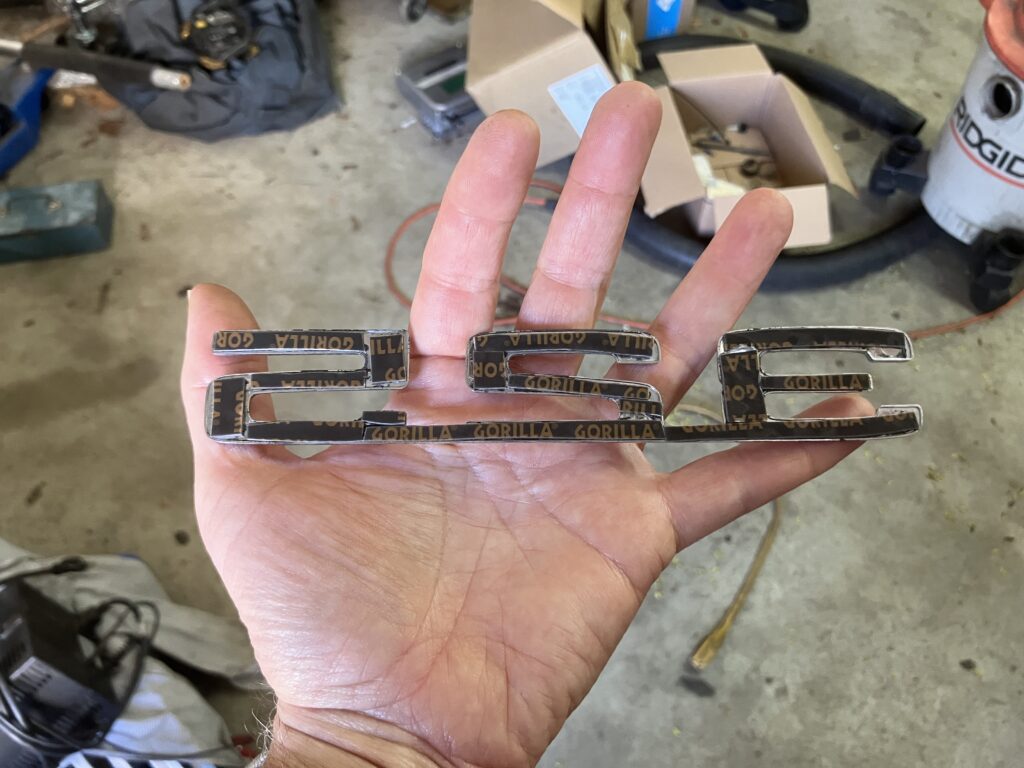
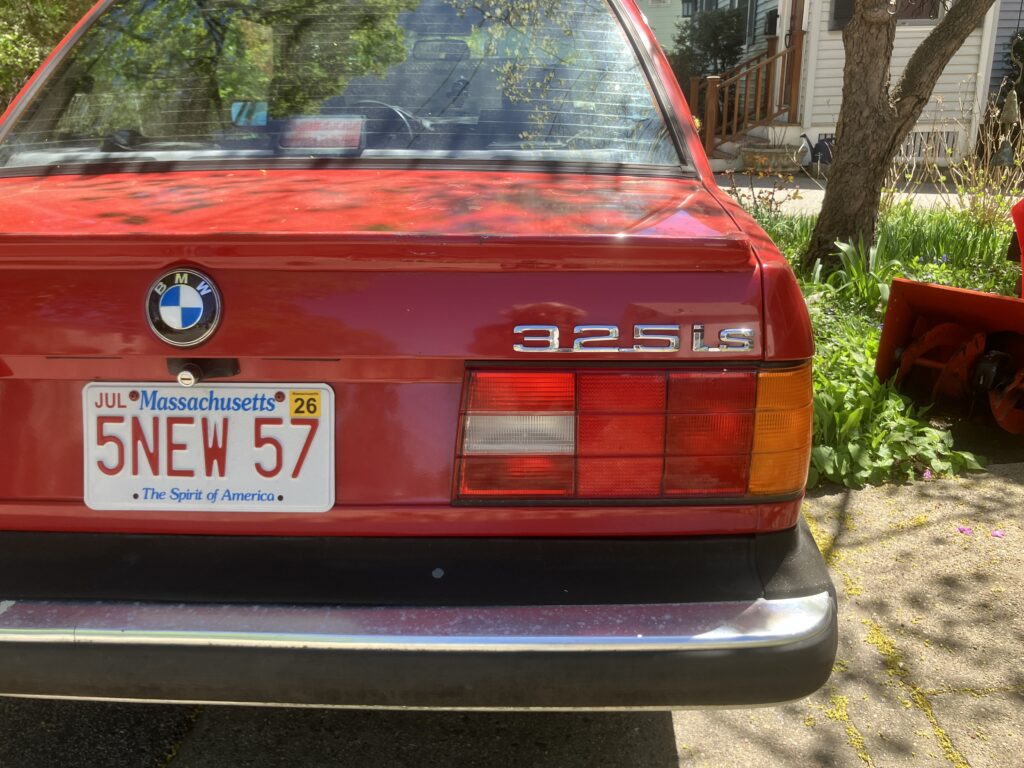
So, that’s it. Hopefully the next post you see will be that the FrankenThirty and I arrived at The Vintage with so little drama that I spent an hour repositioning the badge.
—Rob Siegel
____________________________________
Rob’s newest book, The Best of The Hack Mechanic, is available here on Amazon, as are his seven other books. Signed copies can be ordered directly from Rob here.
Tags: exhaust repair mouse smell Vintage
